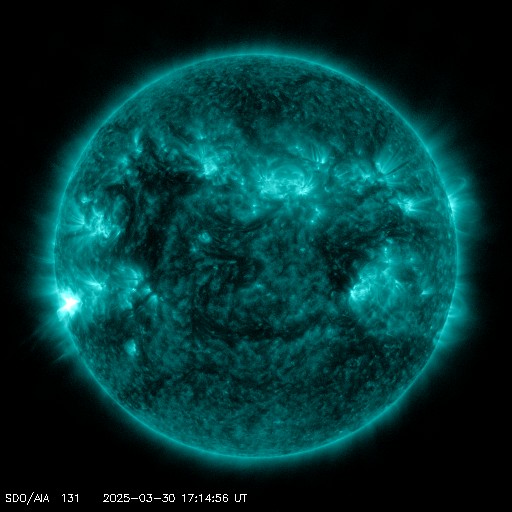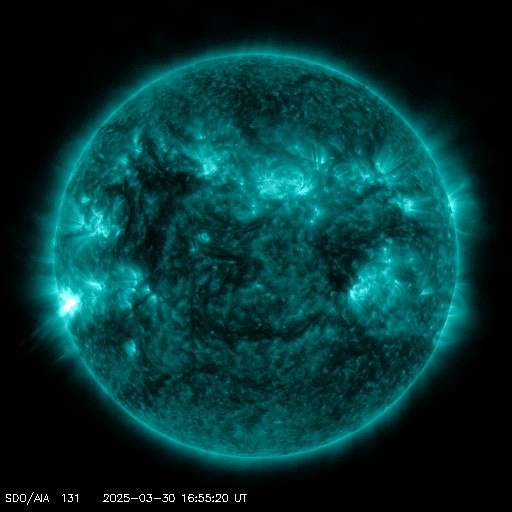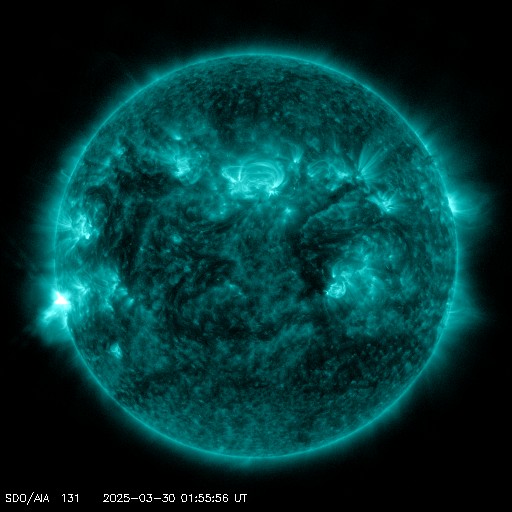Viewing archive of Friday, 7 March 2003
Solar activity report
Any mentioned solar flare in this report has a scaling factor applied by the Space Weather Prediction Center (SWPC). Because of the SWPC scaling factor, solar flares are reported as 42% smaller than for the science quality data. The scaling factor has been removed from our archived solar flare data to reflect the true physical units.
Report of Solar-Geophysical Activity 2003 Mar 07 2200 UTCPrepared by the NOAA © SWPC and processed by SpaceWeatherLive.com
Joint USAF/NOAA Report of Solar and Geophysical Activity
SDF Number 066 Issued at 2200Z on 07 Mar 2003IA. Analysis of Solar Active Regions and Activity from 06-2100Z to 07-2100Z
Solar activity continued at very low levels. Region 296
(N13W18), a relatively large and moderately complex region, has been
dormant for the duration of its transit on the visible disk. This
region was in a slow decay phase over the past few days, but still
shows some complexity. Region 301 (N22W05) though small, is in a
slow growth phase, and exhibited considerable plage fluctuations and
minor surging throughout the period. Newly numbered Region 306
(N05E76) rotated into view this period; a relatively large sunspot
group is evident, but limb proximity hinders a more thorough
analysis. This region was the likely source of a large CME observed
off the NE limb early on 6 March. Three other new sunspot groups
emerged today and were numbered as 303 (S18W47), 304 (S13W16), and
305 (S22E27).
IB. Solar Activity Forecast
Solar activity is expected to be low.
Regions 296, 301, and 306 all have potential for C-class flares.
There is a slight chance for an M-class flare from Regions 296 and
306.
IIA. Geophysical Activity Summary 06-2100Z to 07-2100Z
The geomagnetic field was quiet to active. Isolated active periods
were observed during local nighttime hours at all latitudes. The
high speed coronal hole stream responsible for the disturbed periods
over the past few days has gradually declined to near normal levels.
The greater than 2 MeV electron flux at geosynchronous orbit reached
high levels again today.
IIB. Geophysical Activity Forecast
The geomagnetic field is
expected to be predominantly quiet to unsettled. Isolated active
periods are possible at mostly higher latitudes.
III. Event Probabilities 08 Mar to 10 Mar
| Class M | 15% | 20% | 20% |
| Class X | 01% | 01% | 01% |
| Proton | 01% | 01% | 01% |
| PCAF | green | ||
IV. Penticton 10.7 cm Flux
Observed 07 Mar 150 Predicted 08 Mar-10 Mar 155/160/160 90 Day Mean 07 Mar 142
V. Geomagnetic A Indices
Observed Afr/Ap 06 Mar 015/025 Estimated Afr/Ap 07 Mar 012/012 Predicted Afr/Ap 08 Mar-10 Mar 010/012-010/012-008/010
VI. Geomagnetic Activity Probabilities 08 Mar to 10 Mar
| A. Middle Latitudes | |||
|---|---|---|---|
| Active | 25% | 20% | 20% |
| Minor storm | 05% | 01% | 01% |
| Major-severe storm | 01% | 01% | 01% |
| B. High Latitudes | |||
|---|---|---|---|
| Active | 30% | 25% | 25% |
| Minor storm | 05% | 05% | 05% |
| Major-severe storm | 01% | 01% | 01% |
All times in UTC
Current data suggests there is a slight possibility for aurora to appear at the following high latitude regions in the near future
Norilsk, VorkutaLatest news
Latest forum messages
More topicsSupport SpaceWeatherLive.com!
A lot of people come to SpaceWeatherLive to follow the Sun's activity or if there is aurora to be seen, but with more traffic comes higher server costs. Consider a donation if you enjoy SpaceWeatherLive so we can keep the website online!

Latest alerts
17:27 UTC - Solar flare
Moderate M1.5 flare
17:03 UTC - Solar flare
Moderate M1.61 flare
16:45 UTC - Radio Blackout
Minor R1 radio blackout in progress (≥M1 - current: M1.61)
02:09 UTC - Solar flare
Moderate M1.54 flare from sunspot region 4048
01:42 UTC - Radio Blackout
Minor R1 radio blackout in progress (≥M1 - current: M1.24)
Space weather facts
| Last X-flare | 2025/03/28 | X1.1 |
| Last M-flare | 2025/03/30 | M1.4 |
| Last geomagnetic storm | 2025/03/27 | Kp5 (G1) |
| Spotless days | |
|---|---|
| Last spotless day | 2022/06/08 |
| Monthly mean Sunspot Number | |
|---|---|
| February 2025 | 154.6 +17.6 |
| March 2025 | 127.5 -27.1 |
| Last 30 days | 127.5 -24.7 |





